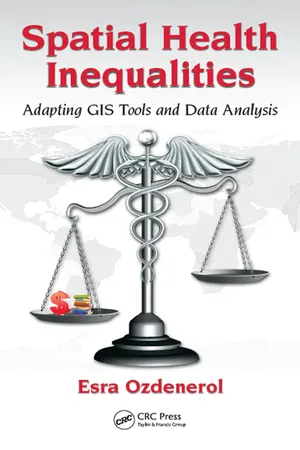
- 173 pages
- English
- PDF
- Available on iOS & Android
About This Book
The neighborhoods and the biophysical, political, and cultural environments all play a key role in affecting health outcomes of individuals. Unequal spatial distribution of resources such as clinics, hospitals, public transportation, fresh food markets, and schools could make some communities as a whole more vulnerable and less resilient to adverse health effects. This somber reality suggests that it is rather the question of "who you are depends upon where you are" and the fact that health inequality is both a people and a place concern. That is why health inequality needs to be investigated in a spatial setting to deepen our understanding of why and how some geographical areas experience poorer health than others. This book introduces how spatial context shapes health inequalities.
Spatial Health Inequalities: Adapting GIS Tools and Data Analysis demonstrates the spatial health inequalities in six most important topics in environmental and public health, including food insecurity, birth health outcomes, infectious diseases, children's lead poisoning, chronic diseases, and health care access. These are the topics that the author has done extensive research on and provides a detailed description of the topic from a global perspective. Each chapter identifies relevant data and data sources, discusses key literature on appropriate techniques, and then illustrates with real data with mapping and GIS techniques. This is a unique book for students, geographers, clinicians, health and research professionals and community members interested in applying GIS and spatial analysis to the study of health inequalities.
Frequently asked questions
Information
Table of contents
- Cover
- Half Title
- Title Page
- Copyright Page
- Dedication
- Table of Contents
- Foreword
- Preface
- Acknowledgments
- Author
- Introduction
- 1: New Emerging Trends in Health Information Technology
- 2: Chronic Diseases
- 3: Birth Health
- 4: Infectious Diseases
- 5: Children’s Lead Poisoning
- 6: GIS’s Applications in Health-Care Access
- Conclusion
- Index